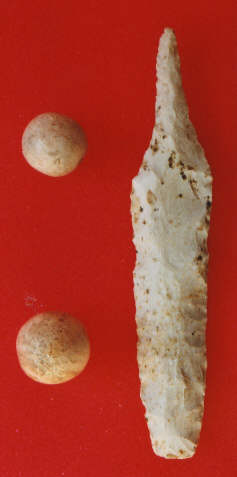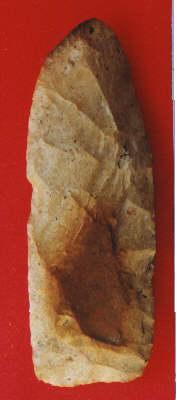|
THE DAY THE BIG ONE CAME
OUT OF THE GROUND |
John Dunn |
| Central States Archaeological Societies 2001
July Journal |
Daphne, Alabama |
|

|
| Etley point found in Audrain County, Missouri, by John
Dunn in 1962. All
photos by John
Wildnauer. |
The year was 1962. My wife and I lived and worked in Oakland, California. My parents lived
in Callaway County, Missouri. Over the years we kept in touch mostly through letters; however, on special occasions
we would use the phone. One Sunday evening the phone rang and it was my mother. After visiting about the family,
Mom said, "Your dad has something to tell you about Indian rocks." To Mother, arrowheads, spear points,
and axes were just Indian rocks. When Dad got on, I could tell from the tone of his voice that he had made a good
find. How good it really was, I would not know for several months.
Dad went on to tell me about stopping by a site that
he had heard about one day after work. After getting permission from the owner of the farm to hunt, he made his
way over to some recently plowed ground. The site showed promise as there was "chipping seemingly everywhere."
His success that day consisted of a few broken pieces. But his eyes and mind targeted on an area near the southwestern
corner of the field. There were three separate circular areas, each about 10 feet in diameter where the soil was
much darker looking than the surrounding soil.
It was getting late, but Dad had resolved to go back
to the site at some later time for more extensive exploration. He returned a few days later, and out of the plowed
earth came a beautiful Etley point about 5 inches in length. It was perfect except for one missing ear. I do not
recall the number of points he said he recovered that day, but it was several.
Over a period of several months his letters told me of more and more Etleys both large and
small, that had surfaced.
By this time he was into the second circle, and the finds
were still coming. I could stand it no longer. I picked up the phone and got Dad to promise he would not start
on the third circle until I got back to Missouri. In July of that year, my wife and I flew from San Francisco to
Kansas City, where my brother met us and loaded us into his car. We made a bee-line to Auxvasse, Missouri. I had
hardly kissed Mother hello before Dad said, "Are you ready to go hunting?" But before that, Dad had to
show me all the pieces he had found. They were unbelievably beautiful. I think I would have killed had someone
said I could not go hunting. Dad was true to his word and had saved the third circle. Dad had also gotten permission
from the farmer to do some minor excavating, as long as we restored the ground when we were finished. The next
four days saw me doing more physical work than I had done in a long time. Dad had determined that these circular
areas had been refuse pits. My pit yielded a large number of points, both whole and broken, but not all were Etleys.
Several drills were discovered along with
pecking stones and scrapers but no axes. Then finally,
I saw the base of a big Etley. I removed the dirt from around it. There it lay in all its beauty; it was the biggest
Etley of them all, 6 1/4 inches long. I sat down in the dirt and thought about the man who had made this beautiful
tool some four thousand plus years before. What a craftsman he must have been. Did he discard it because of the
broken ear, or lose it and forget about it?
One interesting note is that several of the points found
at this site had a missing ear.
|
w
|

|
Above: scraper/biface with a ground butt end. The reverse side shows a great deal of use polish.
From the collection of John Dunn.
Left: drill made from a reworked Nebo Hill point and two stone game balls found in Adair County,
Missouri, by John Dunn. |
I remember a story in one of our journals a few years back when a young man plowing a field
turned up a blade that was over 13 inches long. What a find!
His mother thought of it as just another Indian rock
and sold it to a peddler for a dime. It is so sad that this collector does not have this "Indian rock"
today.
In closing, I share my collection with local Cub Scouts, and there is much joy when these
seven year olds see and feel these beautiful works of art.
This activity, gives me as much joy as they get. I
am fortunate to have had a father who found and shared a refuse pit from eons ago.
|




